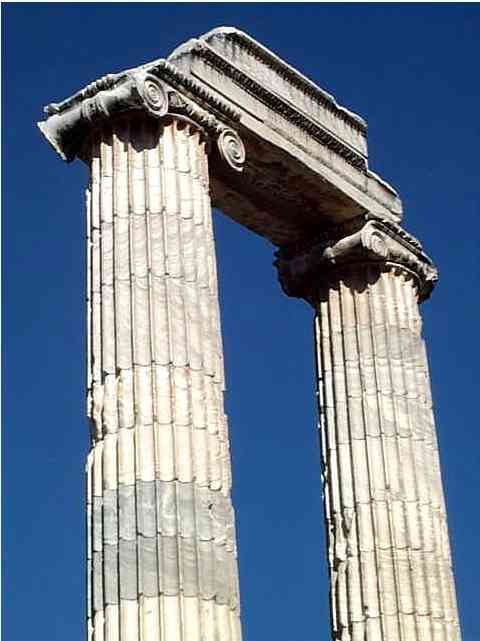![]()
Bergamum, Ephesus & others
|
|
Bergamum, Ephesus & others |

Marvelously conserved columns in Didyma's (Didymium) temple of Apollo, Southern Turkey
| Classical sites in Turkey |
| Italy and Greece have a fair
share of cities and monuments from antiquity, Libya and North Africa might
have a few but nowhere have we seen so many as in Turkey. Along its
Mediterranean coast, several thousand km long, Turkey is literally
peppered with many of the most famous sites from Classic Hellenic culture.
To name just a few : Troy, Pergamum, Ephesus, Miletus and Aphrodisias.
Most modern Turkish cities have a Roman past and a good number are
mentioned in the Old Testament.
|
|
|
|
The 15,000 seat Great Theater of Miletus
|
| Priene, Miletus & Didyma |
| Just south of Ephesus and not
as busy with tour groups (unlucky but happy looking British tourists with
stickers "P&O group 32" proudly displayed on their chests)
are the ruins of 3 ancient settlements : Priene, Miletus & Didyma.
Priene is on a hill side overlooking the plain of the river Meander, where
the Mediterranean used to come. It is a planned city with streets laid out
in a grid. All of the planning is very visible today as we walked from
street to street to visit the important city buildings : the bouleuterion
or city council, the temple, theater and all important gathering places of
the times.
|
|
|
|
Priene's Temple of Athena (left), theater with carved VIP seat (centre) and fallen columns (right)
|
|
|
|
Five small puppies were hiding in the ruins of Miletus looking for caring owners (we were thinking of hiding one in Troopie's glove box for the rest of the trip !), Didyma's famous and expressive Medusa head.
|
| Didyma is famous for its
temple of Apollo that housed an oracle as important as the one in Delphi.
Didyma was never a real town but just housed the priests living a comfortable
life handing out good luck cookies of the times. Of the three sites,
Miletus was the one we mere most excited to explore. If the theater is the
most visible structure left together with the agora and the Baths of
Faustina (Emperor Marcus Aurelius' wife), Miletus was used well after
Roman times. A Seljuk mosque dating from the 15th century was one corner
of the site we had for ourselves.
|
|
|
|
Seljuk and Ottoman graves, the mihrab, Ilyas Bey mosque with a stork nest on its rooftop sickle !
|
| Perge & Aspendos |
|
|
|
Colonnaded streets in Perge (left), the great (and much restored) theater at Aspendos (centre & right)
|
|
|
|
Not all has been restored. Hundreds of columns and frontons lie on the ground, untouched for centuries (Perge)
|
| Hierapolis & Pamukkale |
| Hierapolis is the name of a
large spa city built by the Romans, now better known as Pamukkale, on
Unesco's list of world heritage sites. Pamukkale and its gleaming white
calcium formations must one of the most famous images on Turkish holiday
brochures. From a distance, we noticed the face of a mountain ridge
completely white. Warm calcium-rich water poured over the mountain and
deposited its calcium on the mountain flank. Over the centuries. this
calcium has built pools and stalactites ! Hierapolis was founded around
190 BC as a cure centre and prospered under the Romans and the kingdom of
Bergamum.
|
|
|
|
|
|
The Roman baths at Sardis (left), a sarcophage covered by calcium over the years (the cure did not work for everyone) (centre), the stunning colonnaded Frontinus Street at Hierapolis (right)
|
| Aphrodisias & Ephesus |
|
|
|
Aphrodisias has been amazingly excavated and put back together to "look" a little more as it did many centuries ago. It was cold, windy but sunny !
|
|
|
|
Ephesus where we were joined by Kathleen's parents to drive up to Istanbul !
|
|
|
|
Ephesus' splendid if totally reconstructed "Library"
|
We are doing well !
| Antalya | Back to Trip page | Car & camping in Turkey |